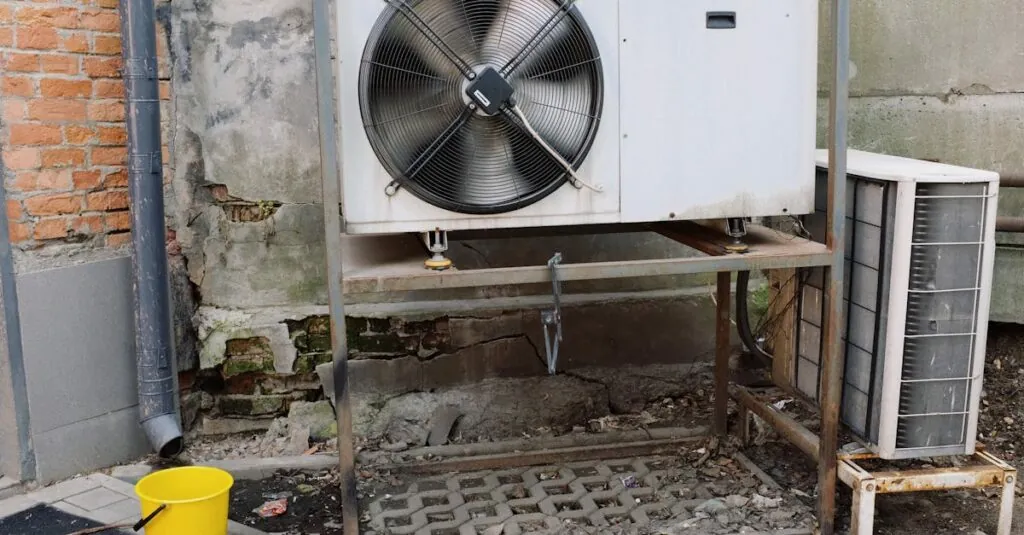Table of Contents
ToggleInstalling a new air conditioner is like getting a shiny new toy—exciting and full of promise. But before diving into that sweet, cool relief, there’s one burning question: how long should you wait before flipping the switch? Patience might not be your strong suit, especially when the summer heat is relentless, but trust us, this waiting game is worth it.
Importance of Proper Air Conditioner Installation
Proper installation of an air conditioner ensures optimal performance and longevity. Cool air circulation and energy efficiency depend heavily on how well the unit is set up. Potential problems arise when installation is rushed or done incorrectly, causing issues like leaks or reduced airflow.
Warranties often require professional installation for validity. Many manufacturers specify that failing to follow installation guidelines can void the warranty. Following correct procedures helps avoid unnecessary repair costs and service calls.
Improper leveling can lead to inefficient performance. An uneven unit might strain the compressor, leading to higher energy costs and downtime. Ensuring the condensing unit is level encourages proper drainage and efficient operation.
Correct refrigerant levels significantly impact system performance. Too much or too little refrigerant forces the system to work harder, ultimately decreasing efficiency. Certified technicians conduct checks to ensure proper refrigerant levels during installation.
Duct sealing and insulation play vital roles in air conditioning efficiency. Leaky ducts can result in significant energy loss, which means air conditioned spaces don’t cool effectively. Proper sealing during installation prevents this energy loss and enhances comfort.
Furthermore, the placement of the outdoor unit matters. An adequately positioned unit ensures unobstructed airflow, reducing stress on the system. Proper placement also minimizes noise and maximizes cooling efficiency.
Taking time to ensure proper installation leads to a unit that performs well and lasts longer. Waiting before using the air conditioner also allows for necessary settling of the refrigerant and components, thus avoiding potential damage right after installation. Following these best practices guarantees a comfortable indoor environment during the hot months ahead.
Factors Influencing Wait Time
Specific factors play a crucial role in determining how long to wait before turning on an air conditioner after installation. Understanding these elements can help maximize the unit’s performance.
Type of Installation
Professional installation affects wait time significantly. If a qualified technician completes the installation, a wait of at least 30 minutes ensures the system settles properly. Technicians often check refrigerant levels and make adjustments during installation. If a DIY installation occurs, waiting 1 to 2 hours allows for any potential issues to stabilize. Taking time after installation helps avoid complications, ensuring the air conditioner operates efficiently.
Weather Conditions
Weather conditions also impact wait time after installation. High humidity levels can cause moisture to gather inside the unit, necessitating a longer wait of 1 to 2 hours. On the contrary, dry conditions may permit activation after just 30 minutes. Temperature fluctuations can affect the refrigerant’s pressure, so ideally, operators should check ambient conditions before turning on the air conditioner. Monitoring weather can prevent service issues and contribute to a seamless cooling experience.
Manufacturer Guidelines
Consulting manufacturer guidelines is essential before operating a newly installed air conditioner. Many manufacturers recommend waiting a specific duration based on the installation method. Units installed by professionals often require at least 30 minutes for the refrigerant and components to stabilize. For DIY installations, a wait time of 1 to 2 hours is typically advised, allowing for potential adjustments.
Manufacturer instructions provide insights into proper operation protocols. Following these can help avoid premature wear and ensure optimal performance. Each air conditioner model may have unique specifications regarding the wait time. Therefore, reading the user manual is crucial to understand specific requirements.
Specific environmental factors impact the wait time as well. High humidity levels can lead to longer wait periods, while dry conditions may allow activation sooner. Additionally, performance can be compromised if the unit is turned on too quickly following installation. Checking ambient conditions ensures more effective cooling once the system is operational.
Adhering to guidelines helps maintain warranty validity. Many warranties stipulate that the unit must be installed according to the manufacturer’s recommendations. Ignoring these guidelines could result in a voided warranty, ultimately costing more in repairs. Following the rules set by the manufacturer supports smoother operation and enhances longevity.
Taking these precautions ensures a comfortable indoor environment during the hot summer months.
General Recommendations
Waiting before turning on a newly installed air conditioner helps ensure optimal performance. Specific guidelines exist to determine those wait times.
Typical Waiting Period
Professional installations typically require at least a 30-minute wait. DIY installations often necessitate a wait of 1 to 2 hours. This time allows refrigerant levels to stabilize and ensures the unit operates efficiently. In high humidity environments, extending the wait might be advisable. Always consult the manufacturer’s recommendations for model-specific guidelines. Adhering to these timeframes prevents premature wear and aids effective cooling.
Signs That It’s Safe to Turn On
Listening for unusual noises can indicate safe operation; if none exists, the unit is likely ready. Observing the environment adds another layer of assurance; if the indoor temperature feels stable, activating the air conditioner is reasonable. Checking for leaks around connections or refrigerant lines is essential; absence of leaks signifies readiness. Familiarity with the energy-efficient features simplifies operation; understanding those features verifies the unit’s proper installation. Lastly, reviewing the manufacturer’s manual provides essential insights into safe activation procedures.
Common Mistakes to Avoid
Neglecting to follow manufacturer guidelines may lead to activation difficulties. Each air conditioner model comes with specific recommendations for wait times, and ignoring these can affect performance. Overlooking refrigerant levels after installation often results in inefficient operation. Checking these levels helps ensure the system runs optimally and avoids potential damage.
Rushing to turn on the air conditioner right after installation shows impatience. Waiting allows the unit to stabilize, especially for DIY installations, which may need 1 to 2 hours. Failing to monitor ambient conditions also poses risks; high humidity can require longer wait times, while drier environments might allow activation after 30 minutes.
Ignoring unusual sounds or signs of instability once the unit is on can indicate underlying issues. Observing these signals ensures the system operates smoothly and helps avoid costly repairs. Avoiding inspections for leaks around connections or refrigerant lines could result in refrigerant loss, negatively impacting cooling efficiency.
Not prioritizing professional installation might void the warranty. Many manufacturers stipulate that a certified technician must install the unit to maintain warranty validity. Skipping a thorough review of the manual before activation may lead to misunderstandings about the system’s function and features. Proper knowledge enhances user experience and improves air conditioner efficiency.
Waiting before turning on a newly installed air conditioner is essential for optimal performance and longevity. By allowing time for the system to settle and ensuring proper installation, users can avoid potential issues that could lead to costly repairs. Following manufacturer guidelines is crucial to maintain warranty validity and achieve efficient operation.
Listening for unusual noises and checking for leaks can help determine readiness for activation. Ultimately, taking the time to ensure everything is in order will lead to a more comfortable indoor environment during the hot summer months. Patience pays off when it comes to enjoying a cool and efficient air conditioning experience.







